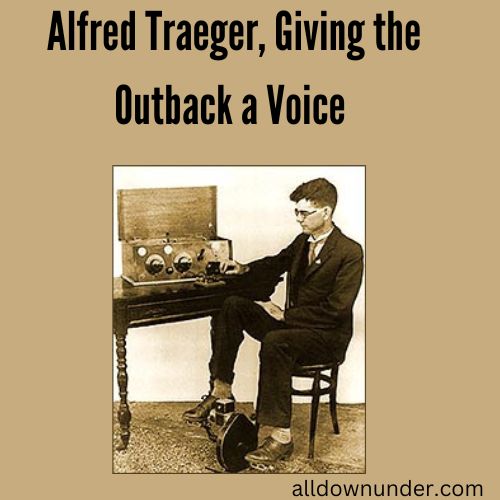Alfred Traeger and is credited with inventing the electric appliance as we know it today.
Young Inventor
Alfred Hermann Traeger was born on 2 August 1895 at Glenlee, Dimboola, Victoria, and grew up on a farm in Balaklava, South Australia.
As a curious and a very inventive 12 year old boy, Alfred made a telephone receiver using mostly odds and ends found around his farm. He used it to transmit messages between his family’s tool shed and their house 50 meters away. Alfred ingeniously made the diaphragm for the earpiece from a tobacco tin lid, the magnet from the prong of a pitchfork, and the carbon for the microphone came from the kitchen stove.
His interest in working with radios developed even more when at 16 years old he received a scholarship to study mechanical and electrical engineering at the South Australian School of Mines and Industries.
In 1923 Alfred worked for Hannan Bros Ltd in Adelaide where he repaired car generators and solved electrical problems. During this time he obtained an amateur operator’s license and used the call sign VK5AX. Radio was still his passion.
Start of the Royal Flying Doctor Service
Hearing about Alfred’s love and knowledge of radio, a man named John Flynn approached him with a request. Flynn was trying to create an inland aerial medical service for remote communities in the outback. (This would become the Royal Flying Doctor Service.) What he needed was a cheap, efficient radio so outback homesteads could communicate with a central medical home base.

So in 1926 Flynn hired Alfred and the two went to Alice Springs in the Northern Territory to conduct some experiments. The first experiment was to set up 3 locations: a base station in Alice Springs and two other locations approximately 100 kilometres apart.
They were able to prove that they could transmit messages over great distances using simple equipment. However, they also found that the large batteries they used were a problem – too heavy and too hard to transport. They were also worried about the acid fumes. But their main problem was that the batteries were simply too big and expensive.
After an working on the problem in the outback, Traeger returned to Adelaide to work on a way to eliminate the batteries. His goal was to create a low cost generator capable of producing about 20 watts of DC power that would be capable of running a high frequency transceiver.
Pedal Power
Alfred’s first idea was to fit a generator to an emery wheel and turned it by hand to generate the electricity. Unfortunately this meant the operator would only have one hand free to operate the equipment. Alfred rejected this. Instead he decided to adapt a WW1 idea and use pedal power.

Alfred attached bicycle pedals to the emery wheel and secured it to the floor so it wouldn’t move when pedalled hard. This allowed a person to generate the power needed by the transmitter while having both hands free. Unfortunately uneven peddling caused the frequency to change which meant part of the transmission would be lost. He solved this problem by adding crystal frequency stabilizers from the USA.
Alfred’s invention would soon transform communications in isolated areas of the world. He built the first ever pedal transmitter-receiver in 1929 at a then cost of £33 ($66).
Morse Keyboard
The first design had its limitations. The homestead could receive voice, but had to return messages by Morse code, which was hard to learn and master.
Alfred’s next invention was the Morse Keyboard. This clever twist on a typewriter meant that the user did not have to know or learn Morse code. The user simply hit a typewriter key on the Morse Keyboard and the corresponding Morse signal would be sent.
The first pedal sets had been introduced in Queensland in June 1929 at Augustus Downs. This was 320 km north of Cloncurry, Queensland, where the first Flying Doctor service started a year earlier in May 1928.
Alfred continued to perfect his invention and in 1935 built a transceiver that could transmit voice in both directions. This was an important improvement. It allowed the outside world to enter the outback thus diminishing the isolation endured by the homesteaders.
School of the Air
More than 30 years after the first model left the Traeger factory, pedal sets were still being sold in countries such as Nigeria. Ten years after that Traeger’s firm provided the sets to the School of the Air in Canada, an educational radio network. In Australia, his sets were used in the School of the Air.
Memorial
Traeger continued to invent a variety of things from a turbine-driven car to the use of solar power to convert salt water to fresh water.
Alfred Hermann Traeger died in Adelaide on 31 July 1980 at Rosslyn Park, Adelaide, and was buried in Centennial Park cemetery. At a sports field in Alice Springs a plaque was erected and the Royal Flying Doctor Service added one of their old aeroplanes to his memorial.
Alfred was the eldest son of Johann Hermann Traeger, a farmer, and his wife Louisa, née Zerna, both South Australian born. His grandparents migrated from Germany to Australia in 1848.
Alfred was educated at Balaklava Public School and the Martin Luther School before spending two years at technical high school. He received an Associate diploma from South Australian School of Mines and Industries in 1915. Alfred Hermann Traeger was awarded an OBE in 1944.



